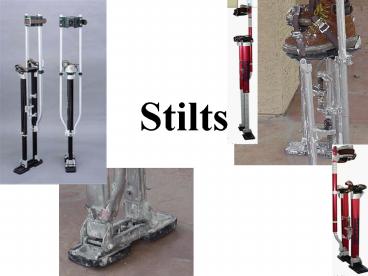Stilts PowerPoint PPT Presentation
1 / 17
Title: Stilts
1
Stilts
2
Stilts
- First stilts used in France during the 1870s for
walking through marshes. - The 4 major types of stilts are
- Hand-held
- Peg
- Spring
- Drywall
3
Hand-held
- Hand-held pole stilts
are made of
two long
poles, each with a
foot support on them. - The stilter holds on
to the upper end of
the
pole and rests
their
foot on the foot
plate. - Usually homemade
and used by children.
4
Peg
- Peg stilts, also known as Chinese stilts, are the
most common stilts used by professional
performers. These stilts strap on at the foot,
ankle, and knee and give the walker a great deal
of flexibility in what they can do. The light
weight stilts make it possible to walk fast, make
fast direction changes and dancing (fast turns).
5
Spring
- Spring stilts or jumping stilts were introduced
in 2004 under the trademark Poweriser and are
marketed for recreational and extreme sports use.
6
Drywall
- Drywall stilts are used in many areas of life.
Because of the possibility of standing still and
natural walking motion, it's used by many
painters, workers, actors, and magicians. Drywall
stilts are heavier than peg stilts and made for
slower but safer walking and working and are the
most safe of all stilts, and used by
approximately half of the pros.
7
Drywall cont.
- Dura Dura stilts are a type of dry wall stilt.
Dura Stilts employ a spring system, which act as
servos to the muscle system, and dual leg
sections transfer movement from the ankle to the
ground. Pivot points under the heel and ball of
the foot allow a natural walking motion, and
large soles promote stability.
8
Drywall cont.
- Dura Stilts is the most successful commercially
available stilts design. There are now many
companies that produce a copy of this type of
stilt, though the category continues to be known
as dura stilts.
9
Safety
- A total of 3.4 million was paid on 277 claims
from 1996 to 2002. - The median cost of compensable claims was 7,223,
and these claims caused a median of 73 lost
workdays. - The majority of injuries reported were by drywall
subcontractors.
10
Leading Causes
- Falls accounted for 65 of all claims
- The next leading cause of injuries related to the
use of construction stilts was overexertion.
11
Fall Avoidance
- Identify and remove objects that may result in a
fall. - Share information on stilt hazards with other
trades helps with housekeeping efforts. - Be trained to recognize items that are potential
fall hazards. Items can be as large as a job box
and as small as a nut or screw.
12
Overexertion
- Using only high-quality, well-maintained stilts
to reduce the stress they can place on the body. - Rotating tasks so that part of the day is spent
off stilts. - Instructing all employees who wear stilts how to
inspect, maintain and properly wear the
equipment. - Using extreme care when putting on and taking off
stilts, as injuries have occurred during these
tasks.
13
OSHA
- Stilts are covered under
- 1926.452(y)
- Only discusses wearing stilts while working on
scaffolding.
14
OSHA Says
- An employee may wear stilts on a scaffold only if
it is a large area scaffold. - When an employee is using stilts on a large area
scaffold where a guardrail system is used to
provide fall protection, the guardrail system
shall be increased in height by an amount equal
to the height of the stilts being used.
15
OSHA Says Cont.
- Surfaces on which stilts are used shall be flat
and free of pits, holes, and obstructions, such
as debris, as well as other tripping and falling
hazards. - Stilts shall be properly maintained. Any
alteration of the original equipment shall be
approved by the manufacturer.
16
- There is no question that construction stilts
make some types of construction work easier. - With proper preparation, use and instruction,
that work can be safer, too.
17
Sources
- EMC Insurance Companies Loss Control Insights
for Contractors - Wikipedia http//www.wikipedia.org/

